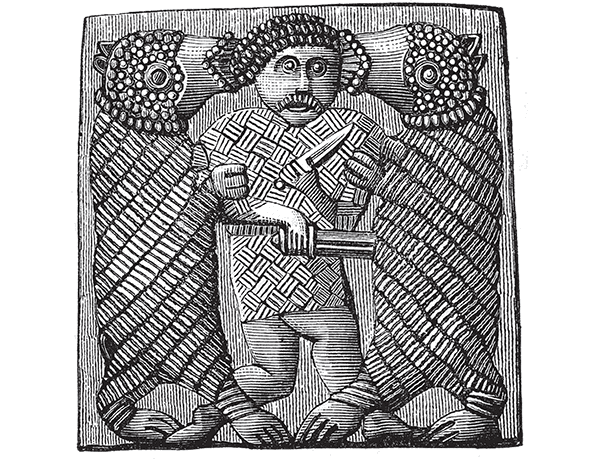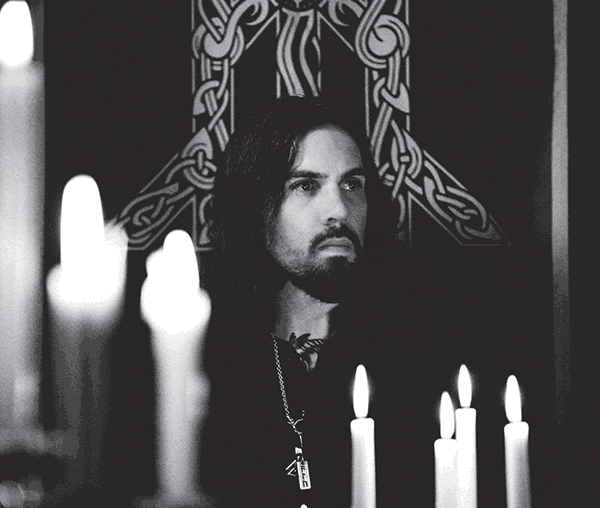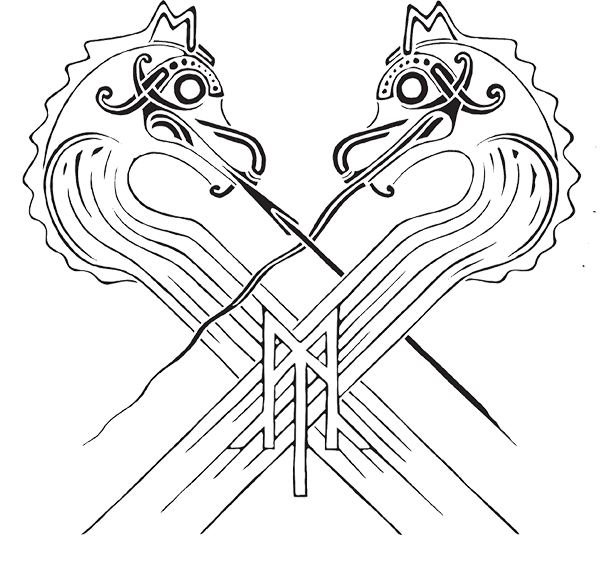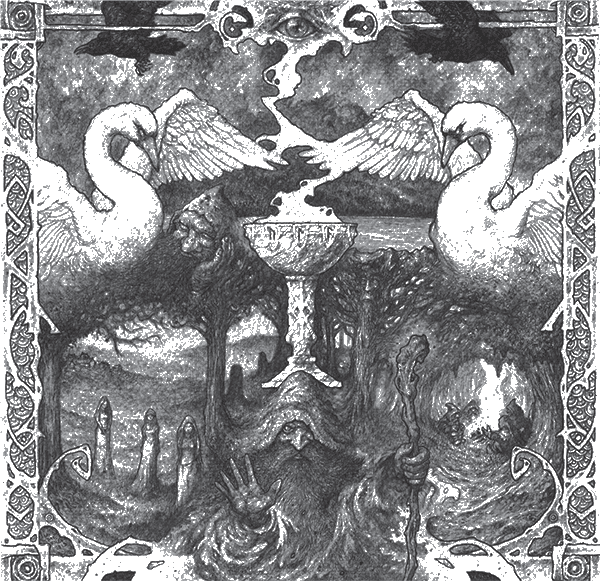Wolcensmen
2019-09-18
by Niklas Göransson
Fire in the White Stone – British neo-folk project Wolcensmen is contemporary art standing on archaic bedrock. Founder and driving force Dan Capp explains how the darker forms of music can serve as a spiritual insurgency against the modern world.
This article can also be found in Bardo Archivology Vol. 2, a printed anthology with selected features from the online archive. Additional content includes NÅSTROND, VOMITOR, NOCTURNUS, XIBALBA ITZAES , Ryan Förster, ANGELCORPSE, THE RUINS OF BEVERAST, ASCENSION, MALOKARPATAN, Manhunter: The Story of the Swedish Occultist and Serial Killer Thurneman, WARDRUNA, FORGOTTEN WOODS, LIFVSLEDA, and SEIGNEUR VOLAND – all presented in ambitious aesthetics with plenty of custom artwork. More information here.

– From the very beginning, WOLCENSMEN was intended to act as a path to altering the listener’s consciousness. As a practising heathen of many years, my most profound spiritual experiences have often been accompanied by the music of bands like BURZUM and ULVER. Their lyrics are pretty much incomprehensible to English ears, yet the music spoke to me more deeply than anything else I’d ever heard. It resonates with a place beyond the mind – the vocabulary of one’s soul. By 2010, fewer and fewer records spoke this language and I wanted to try and reignite it in my own way.
Although formalised in 2010, WOLCENSMEN has its roots in the late 90s when the teenage Dan Capp became obsessed with black metal – especially the evocative acoustic and synth interludes so prevalent during the era.
– This inspired me to record my own little acoustic guitar parts onto cassette using my bedroom Hi-Fi system. I’d pan the mic input all the way to the left to record the main part, then to the right for an accompaniment. A two-track analogue recorder, what more could I possibly need? I didn’t do anything with these early ideas and subsequently dedicated many years to more mundane electric guitar activities. Around 2010, after watching a random folk band in Dublin, Ireland, I felt inspired to finally do something of my own – but something overtly English. I spent a couple of years writing three songs and, eventually, in 2013, recorded a demo in my attic. I didn’t have particularly big plans for the project; however, the demo started garnering some interest after I put it up on Bandcamp, mainly from the dungeon synth crowd. A small label from Germany, Deivlforst Records, insisted on releasing the demo and then encouraged me to make an album, so I did.
Dan recorded the debut WOLCENSMEN album, “Songs from the Fyrgen”, on his own equipment and released it on Deivlforst in November 2016. I read in an older interview that he feels far more comfortable as strictly a composer and musician, as opposed to also acting studio engineer and producer. As luck would have it, the new album has none other than John Rivers – who co-produced early DEAD CAN DANCE albums such as “The Serpent’s Egg”, “Within the Realm of a Dying Sun”, and “Spleen and Ideal” – filling the latter role.
– I was originally booked to record with Markus from EMPYRIUM, whose work I’m a big fan of. Sadly, and for reasons I won’t go into, that plan fell apart. I considered who else I could approach to produce the album and realised that, as far as atmospheric music goes, I don’t think anyone has surpassed John’s achievements with DEAD CAN DANCE. So, I went out on a limb and looked him up to see whether he was still active and if we might work together. He was and so we did!
“Fire in the White Stone” was realised in Woodbine Street Recording Studio – the same Warwickshire facility where DEAD CAN DANCE recorded a lot of their classic material.
– We worked closely for ten days, ten hours per day, and then more via email and phone to get the mix finished afterwards. John has an incredible ear for sonic quality, both on its way into the desk, the tracking, and on its way out – mixing. With his extensive collection of microphones and other gear, he was right there with me to get the mics positioned perfectly and help make decisions on the right harmonies. John has a young assistant called Eddy Hewitt working with him and he shows a great manner and instinct for his age. We all got on really well and it became a very creative environment as both of them got into the spirit of the project. Recording with John was a real privilege and blessing for the album.
The debut had quite a few guest musicians – who contributed this time?
– Jo Quail on cello, Aslak Tolonen of NEST on kantele, Jake Rogers of VISIGOTH and GALLOWBRAID on flute, Grimrik and Darkest with synths, a folk singer called Julie Russell, and my WINTERFYLLETH bandmates Chris Naughton and Mark Deeks on choral vocals and piano respectively. When creating an album, I always keep the bigger picture in mind – I know the importance of having different textures and dynamics to hold the listeners’ attention and ensure an interesting ‘journey’. There are so many instruments I’d love to learn but, as a man with too little spare time already, the best I can do is borrow the talents of others. Most parts were written by me and then performed and sometimes elaborated on by the guests.

Besides his musicianship, Dan is also a graphic designer and has, in this capacity, handled the layout for five of the post-prison BURZUM records. Something occurred to me in light of the John Rivers connection – having recently seen DEAD CAN DANCE live, I was reminded about how a disproportionate amount of their fanbase appears to be from the black metal scene. I’d actually attribute this partly to Varg Vikernes – in 90s BURZUM interviews, he often mentioned DEAD CAN DANCE as one of his musical influences. That’s how I, and pretty much everyone I knew at the time, first discovered them.
– Although I had a working relationship with Varg for several years, I wasn’t introduced to DEAD CAN DANCE by him. I can’t remember what or who did. But I’m aware that many people discovered them through Varg’s praises. I think the metal fan’s infatuation with DEAD CAN DANCE is due to that love of atmosphere and mysticism we share. Some of their songs are akin to religious experiences, much in the same way the whole of “Hvis lyset tar oss” (BURZUM), “The Shadowthrone” (SATYRICON) or “Kveldssanger” (ULVER) are for me. The music is dark, sophisticated, and unbridled – free from the confines of modern convention.
This brings us back to Dan‘s captivation with the non-metal elements of mid to late-90s black metal. I can certainly understand the appeal, having spent countless adolescent hours walking in the forest whilst listening to those incredible acoustic parts on SATYRICON’s “Dark Medieval Times”. Same with the keyboard interludes on ABIGOR’s “Orkblut”. I discussed precisely this with one of its originators, TT of ABIGOR, and he described the mid-90s European black metal scene as consisting of young men full of inner fire but without much knowing on how to channel it spiritually – whose fervour tapped into some kind of Jungian subconsciousness, out of which emerged these heathen currents and expressions of national romanticism.
– I think what TT said can be summed up by concluding that it was all an expression of romanticism – national or otherwise. STORM’s “Nordavind” album is about the purest example of this I can think of, and, as far as I’m concerned, the spirit they captured is present to varying degrees in all good black metal. Many of us know there’s something missing in our modern existence and although we often can’t explain what that is, we know when we hear it because music speaks to a deeper part of ourselves. This is specifically true of 90s black metal out of Scandinavia, which I think had more serious and ancient undertones than any of the other contemporary scenes; although the flame is being kept alive today in places such as Finland, France, and Poland. All in all, I think we’d be foolish to dismiss black metal as a meaningless expression of dark art.
It’s also interesting to note how much quality neo-folk and associated music is created by musicians with a black metal background. ULVER’s “Kveldssanger”, HEXVESSEL, WARDRUNA, WINTERFYLLETH’s “The Hallowing of Heirdom”, FORNDOM, and so on being fine examples.
– This is no coincidence. Neo-folk reaches for something deep and mystical in the same way most black metal does, and both musical styles are concerned with creating atmosphere and drama. Furthermore, I think both genres tap into that same ageless and initiatory pagan current. I believe all tendencies in life to be timeless and archetypal, and despite this contemporary veneer which might make them seem novel, they are not. We could look at the anti-social, radical philosophy of black metal as merely some new quirk of the modern era, but I think it makes far more sense to view it as the manifestation of an ancient tendency; namely, that of the männerbund. Groups of young men willingly ostracising themselves from society.
The basic definition of the männerbund is a secret brotherhood to which entry is granted exclusively by rites of initiation – a metamorphosis meant for young adepts to cast off their humanity alongside any obligation to heed either the customs or laws of men. The cultists are usually warriors and mystics who worship gods presiding over battle or death, and commonly align themselves with different totem animals in a manner which could be described as lycanthropic ecstasy. Numerous such cults have been documented, from the Americas, Persia, and Egypt to Ancient Greece, West Africa, and India. The type of warrior society Dan refers to derives from martial traditions found among the Celts, Germanic tribes, and in Scandinavia. Details are scarce, but the best-preserved information is about Norse männerbund. Their origins are thought to lie in hunting magic, and known animal cults are those of the wolf, the wild boar, and the bear. The least documented are the boar men, believed to have been frontline fighters who gave their name to the Viking military tactic known as svinfylking, literally ‘boar snout’, which is a wedge-shaped offensive formation designed to break shield walls. As esoterically and philosophically complex as these cults appear to have been, it’s interesting to note how they also constituted the fighting elite in a culture of generally high combative prowess. Both the wolfskins and bear coats, or Úlfhéðnar and Berserkir, were employed as shock troops by soon-to-be King Harald Fairhair in the late 9th century Battle of Hafrsfjord. ‘Berserkers bellowed where the battle raged’ wrote skaldic poet Þorbjörn Hornklofi in his Haraldskvæði. ‘Wolf-heathens howled and iron weapons trembled’. They were Odinic warrior cults seeking to emulate their god’s attributes for both warfare, where he takes animal form and fights in a furious trance, and the quest for hidden knowledge. The latter suggests they disregarded societal norms and morals in their search for gnosis and, like the Poetic Edda states Óðinn himself did, practiced seidr: a kind of shamanistic Norse magic reserved exclusively for women. Men who engaged in seidr were shunned as perverts by polite society, something feared fighters would presumably have paid little heed to. This fusion of shamanistic rapture and predatory battle frenzy has been suggested as the etymological source of the name Óðinn, which comes from woð – a Germanic word used for both ecstasy and fury. After Scandinavia was Christianised, these practices fell entirely out of favour. In 1015, organised war-bands of Berserkir and Úlfhéðnar were outlawed in Norway. Iceland soon followed suit and by the early 12th century they had disappeared from Scandinavia entirely, living on only in legend.
– It took me many years to fully understand what this is all about; the link between black metal and an ancient mindset. I have, for most of my life, been drawn to forms of rebellion that often seemed irrational, but none so profound as black metal. I’m still forming my ideas around this, but I believe the männerbund to have served the vital function of keeping existing society in check and making sure it hadn’t fallen prey to corruption or weakness. These men who lived as bands of wolfsheads in their youth, exploring the dark ‘hinterland’ and dabbling in things like seidr, before returning to their folk bearing a renewed sense of duty and purpose; perhaps even some valuable insight. Most passionate fans of black metal music and philosophy feel this sense of unbelonging and, whether they know it or not, this is because they feel modern mainstream society is deeply flawed. Black metal provides them with a mysticism and vitality – musically and thematically – that’s almost entirely lacking elsewhere in society. I even snuck a musical representation of this theory into my new album; there’s a moment after the ‘wild hunt’ when something grand is revealed to the protagonist, whereupon I briefly play a melody borrowed and adapted from a classic 90s black metal related album. I’ll let the reader work out which one. But this was my way of tipping the hat, despite WOLCENSMEN being non-metal, to show that the spirit of black metal has served as a sort of watershed moment in my life.
Africa has been home to quite a few therianthropic männerbund, but perhaps none so prominent as the Leopard Society. These feline worshippers are known for ritual murder in states of carnivorous possession during which they, believing it will grant them special powers, feast upon the victim’s flesh and blood. The leopard is a powerful totem animal in Africa, believed to have been charged with guiding the dead; its followers honour it by carving and slicing their prey with steel claws held like knuckle-dusters. The phenomenon is believed to have originated out of a late-18th century cannibalistic warrior society in Calabar, an important trade hub in present-day Nigeria from which the locals, known as the Efik, would sell neighbouring tribesmen into slavery. The man-hunting cult spread across adjacent lands and, before long, by the latter half of the 19th century, colonial powers started taking note of them. In 1870, authorities in a French colony in Gabon began finding victims mauled and gashed to the extent where wild animals were first assumed to have been the culprits. Another spate of Leopard Society terror erupted in Sierra Leone during World War I, but nothing compared to the mid-1940s outbreak in eastern Nigeria. Colonial police would later describe the episode as, ‘probably without parallel in the history of violent crime of any country in the world’. In what constitutes an insane story in itself – featuring hidden sacrificial jungle shrines, ritualistic slayings inside law enforcement buildings, and traps using dead policemen – by the time authorities stamped out the menace, it had left over two-hundred civilians murdered and seventy-seven leopard men hanged.
– I’d never heard of this Leopard Society, it’s a pretty extreme example of therianthropic cult behaviour. I’m not aware of Europeans engaging in cannibalism. It seems to me that these Efik people were more willing to abandon all pretences of civilisation and morality, or perhaps had none in the way other ethnic groups did. I feel there’s some strength in moderation – between civil and wild behaviour, objective morality and carnal impulse. We are animals but, for whatever reason, have been bestowed with a capacity for higher thinking, empathy, and self-restraint. What strikes me foremost is how pre-Christian people appear to have been desperate to maintain a strong, ongoing link with the wild and untamed aspect of the human animal. They were, perhaps, wary of how crippling absolute civilisation could be and saw it as a weakness in the struggle for survival. The Norse would’ve seen how domesticated those elsewhere in Europe had become once Christianised, so it might have seemed as if losing all sense of wildness would mean surrendering their way of life. There’s also this idea of destroying the social inhibitions of young men, perhaps to the extent of making them appear so feral as to be foolish. But the ‘fool’ is sacred, because he is the only one who can introduce profound, radical new ideas to a stagnant society. Every genius is seen as a fool until the worth of his ideas has been proven.

Given your interest for religious history, are you into archaeology as well?
– Yes. My wife and I always bonded over an interest in the megalithic sites of Britain and we have for many years brought our copy of The Modern Antiquarian by Julian Cope with us on our travels around the country, so that we might visit new standing stones and long barrows. For example, we recently visited the Castlerigg stone circle at Keswick.
Believed to have been constructed around 3000 BC, Castlerigg is one of the earliest and most important of the roughly three hundred stone circles found across Britain. Thirty-eight stones – originally forty-two – form an open circle about thirty metres (97,5ft) in diameter. Not having been properly excavated, its function remains a mystery; most British stone circles from the Bronze Age are typically burial monuments, but Castlerigg and other Neolithic sites appear to have seen no such use. It’s also unknown what lies beneath the soil.
– It was a profound experience, especially given its location: surrounded by a panorama of mountain peaks. This proved one thing to me, that the ancients valued the same sense of awe some of us do today. Not that this should come as any surprise – religious ritual is really just about altering the consciousness of those present, for this is how fresh innovations and gnostic ‘downloads’ come about, as well as how allegiances and convictions are strengthened. Perhaps it’s true that a person will not sacrifice himself for his kin, either present or yet to come, unless he experiences the emotion and awe inspired by that kind of grandiosity.
Do you know much about Stonehenge?
– I can’t claim to know a great deal about Stonehenge specifically, though I have visited several times. In fact, in my late teens, around the year 2000, I used to go there on the Summer Solstice, which is the only time of year authorities remove the barrier and allow people to wander freely among the stones. It turns into a huge party, with thousands of pagans and hippies descending upon the site. Sadly, many of them dishonour the privilege and use the opportunity to drink bad cider and take drugs, littering all over the place.
The reason I ask is that in 2014, the Stonehenge Hidden Landscape Project concluded their four-year undertaking of mapping out the subterranean landscape surrounding the iconic monument. Using magnetometers and ground-penetrating radar, their survey yielded a startling discovery no one had any clue was there. What had previously been thought of as a lone architectural wonder from antiquity was suddenly shown to be one small piece in a gigantic ceremonial landscape. Among the finds were hundreds of burial mounds – one of which contains a massive wooden building thought to have served as house of the dead – and what appears to be a procession route around Stonehenge, as well as seventeen different ritual shrines. Absolutely mind-blowing stuff that really should force us to rethink much of what we believe ourselves to know about pre-British history. Bizarrely, I don’t recall seeing much coverage about this in mainstream media, not even at the time of its discovery. I just checked the rather extensive Stonehenge Wikipedia entry and it’s not even mentioned in the synopsis, only casually and ever so briefly towards the very end of the page. There is more text dedicated to an incident in 1985 when police forcefully prevented hundreds of New Age travellers from throwing a party on the premises. One would almost think that something unquestionably older and far grander would rouse the smallest bit of interest, but what do I know.
– I do believe much of the official history handed to us to be incomplete or misleading. In fact, my entire worldview is predicated upon the belief that our distant ancestors were wiser than we are, and that their so-called primitivism was not due to a lack of intelligence or creativity. For example, pre-Christian northern Europeans are derided for their lack of written scripture, but my theory is that – rather than not having the intelligence to write – they valued the benefits of the oral tradition, where falsity and oppressive bureaucracy could not flourish. It’s also worth considering: does it really require more cognitive fortitude to read and write a tradition than to remember and recall it? I think it’s important to rethink these things.
Any theories about these standing stones?
– Their purposes were probably multi-faceted and concerned observation of the heavens, energetic geographical lines, the resonance between certain stone and soil, ceremony, and the aforementioned facilitation of awe-filled experience. I’d also add briefly that I think the history of Britain is still largely misunderstood. The simple, proven fact of Doggerland – which once linked these isles to Scandinavia and the European mainland – should be enough to force a rethink on the relationships between the nations of north-western Europe as well as the cross-pollination of their cultural and religious ideas. There’s evidence that a Germanic language was spoken in Britain long before the arrival of the Saxons, Jutes and Angles; possibly even before the Romans brought German mercenaries to these shores. It is partly to these semi-mythical times I hope to carry the listener with my music.

This article can also be found in Bardo Archivology Vol. 2, a printed anthology with selected features from the online archive. Additional content includes NÅSTROND, VOMITOR, NOCTURNUS, XIBALBA ITZAES , Ryan Förster, ANGELCORPSE, THE RUINS OF BEVERAST, ASCENSION, MALOKARPATAN, Manhunter: The Story of the Swedish Occultist and Serial Killer Thurneman, WARDRUNA, FORGOTTEN WOODS, LIFVSLEDA, and SEIGNEUR VOLAND – all presented in ambitious aesthetics with plenty of custom artwork. More information here.



